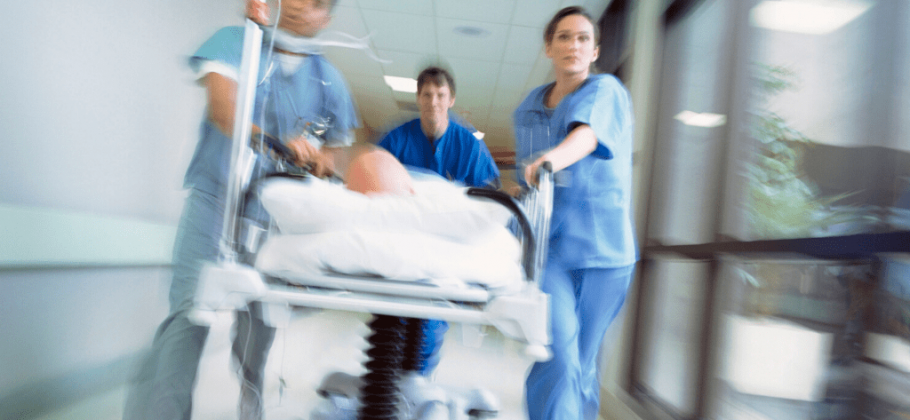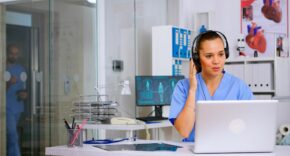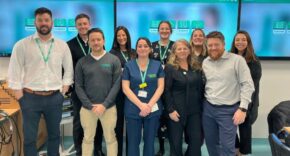Global economic and political turmoil and the climate change crisis may dominate headlines but arguably the biggest threat to global wellbeing is the state of our health care services. In his latest book, global healthcare leader Dr. Mark Britnell, cites a World Health Organisation estimate that by 2030 the world will be short of approximately 18 million health workers – a fifth of the workforce needed to keep healthcare systems going.
Digital disruption is changing industries globally – yet despite the fact that upwards of 36% of healthcare work could be automated, in far too many cases there is a resistance to better using technology to automate administrative and non-clinical activities. While the NHS is considering the use of AI in interpreting 3D scans for diagnosis and referral, for example, the majority of Trusts are still reliant on totally manual processes for bed management.
Deb Sutton, Director of Client Support, TeleTracking, explains the importance of leveraging proven technology to transform bed management and release highly skilled and motivated clinical staff to deliver patient care, while longer term plans for recruiting and retaining new clinical staff come to fruition.
Ten Changes
In the UK, 9.2% of all NHS posts are vacant – a fact that will come as no surprise to anyone on the front line of healthcare delivery. The problem is far from limited to the UK. Globally the shortfall of healthcare workers is predicted to hit 18 million by 2030 and while politicians consistently acknowledge the issue, to date no country has managed to solve this problem.
As Dr. Mark Britnell points out, while politicians laud healthcare staff and celebrate the creation of additional jobs, they have failed to plan how to fill these jobs. Furthermore, they proclaim the value of technology yet fail to prepare for digital disruption. Indeed, in many cases, opportunities to embrace technology that could transform existing processes are actively ignored.
Dr Britnell has suggested ten changes required to address the global health worker crisis, ranging from productivity and new models of care, to communities as carers and creating a managed and motivated workforce. This latter point is absolutely fundamental: while many countries are working to encourage more people into the workforce, training these individuals takes years. To address the current decline in existing clinical staff, health services need to act now to address, for instance, the fact that 76% of doctors and 79% of nurses perform tasks for which they are overqualified and in far too many cases, such work is not even clinical.
Prioritising Care
Clinical staff across the board want to care. Far too many, however, are forced to prioritise admin. Nurses, for example, are continually dragged away from patients to respond to phone calls regarding current and likely bed availability. When hospitals are in crisis, senior nursing teams can meet up to five times a day, for 60-90 minutes each time, discussing patient discharges and bed management, meaning up to 7.5 hours a day is spent on administration rather than care. No wonder one of the main staff complaints is a lack of time to engage with patients.[iii]
Under current bed management models, patients are allocated to the first available bed. Cardiac patients end up in orthopaedic wards, patients with respiratory disorders in geriatric wards. This leads to huge frustration for nursing staff who are often not using their hard earned specialist skills and, even worse, forced to care for patients with complex demands for which they have not trained. It also affects a multitude of clinical staff: from consultants to physiotherapists and pharmacists, far too many highly skilled, time poor individuals embark upon the daily Safari round to find patients who have been placed in the wrong ward simply to hit ED targets.
To avoid the burnout and stress that is contributing to so many experienced clinical professionals leaving the health service, it is essential to release individuals from these tasks and reprioritise time to care. Individuals need to be at the top of their game, not continuously working at the edge of their capacity.
Improving Morale
It is 100% possible to radically improve the day to day experience for clinicians – especially nurses – by improving the bed management process. Combining Radio Frequency ID (RFID) badging with a centralised, co-ordinated bed management system, provides a single source of accurate, up to date information regarding patient location – and bed availability. There is no need to phone each ward in turn – immediately reducing the noise on the wards and freeing up nurses to prioritise patient care.
Staff can then become proactive rather than reactive – for example planning patient discharge from hospital, avoiding the rush that can be stressful for both nurses and patients. Indeed, the entire process can be better managed – from ordering porters to collecting patients to ensuring bed cleaners are on hand to clean and prepare the bed for the next patient, significantly reducing turnaround time. Using this system, Trusts have reported an additional 250 hours a week of nursing time released from admin tasks back to care – hours that can transform not only the patient experience but critically nurse morale and job satisfaction.
Furthermore, with centralised bed management, a trust can reduce the number of outliers, avoiding the need for the daily Safari round, improving the day to day experience for all health professionals. The addition of a digital white board also transforms the daily ward rounds, with the multi-disciplinary teams able to update all patient information immediately, again reducing the admin typically required.
Conclusion
The implications of the global crisis in health workers cannot be ignored – and each winter the issues for our front-line healthcare providers become ever more challenging. Clearly this crisis cannot be solved just be improving bed management – but better bed management requires a relatively simple change that can deliver quantifiable benefits very quickly.
Centralised bed management can improve the experience for every part of the health service. In addition to releasing nurses back to care and reducing the stress inducing noise on the wards, better managed patient discharge creates a far more orderly flow, improving the speed with which patients are admitted from ED. This decompresses the ED department – enabling ambulances to offload more quickly and minimising the frustration of paramedics left waiting outside the front door. GPs can also log onto the system direct from surgeries to find out if a referred patient has been admitted – avoiding the need to call a ward for more information.
Centralised bed management releases capacity back into the system without the need to add beds or staff and provides a chance for new policies regarding recruitment and training of additional staff to be realised. Yet the majority of Trusts are still reliant on inefficient manual processes and individuals dedicated to bed discovery. There are huge opportunities to explore digital technologies throughout healthcare, from AI led diagnostics onwards. Right now however, the priority has to be the retention of essential staff and that means removing admin tasks and ensuring staff can truly utilise their clinical skills. By making this change today, hospitals will not only improve morale and enhance patient care but also have the chance to put essential longer term plans into action.
TeleTracking UK












